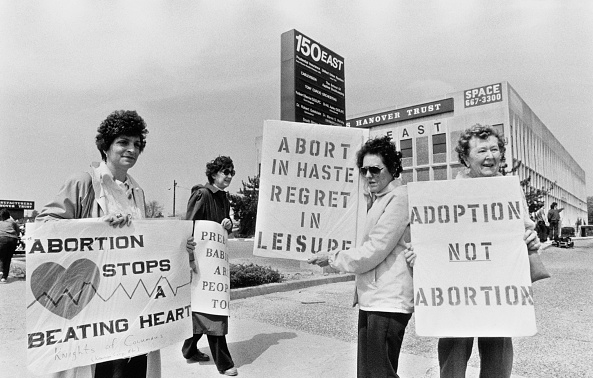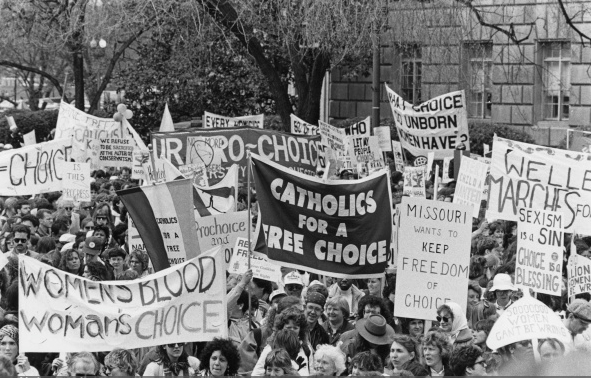Interview by Jennifer Au, Taylor Branch, Sharim Estevez, Evelyn Giovine, Juliette Hackett, Jarron McAllister, Rebecca Neill, and Colleen O’Gorman
This post is part of a new series for NOTCHES, which features students interviewing authors of recent works in the history of sexuality.
Our second entry has students from Gillian Frank’s seminar, Reproductive Politics in the United States and Abroad (taught in the Program in Gender and Sexuality Studies at Princeton University in Fall 2015), posing questions to Mary Ziegler, author of the path-breaking book, After Roe: The Lost History of the Abortion Debate (Harvard 2015). Ziegler studies the ways in which grassroots activists and politicians responded to the 1973 ruling in the two decades that followed it. Using rich archival sources and 100 oral histories, each chapter debunks popular assumptions about the meaning of Roe, a case that decriminalized abortion and vastly increased women’s access to the procedure. Zeigler showcases the political complexity and internal struggles of the pro-choice and anti-abortion movements, and how these movements changed over time, while reshaping the meaning of both Roe and reproductive rights.
The syllabus for Reproductive Politics in the United States and Abroad, which can be viewed here, introduced students to the histories of ideas and practices governing abortion, adoption, contraception, procreation, and parenting, and emphasized how each shifted over time and underpinned major social struggles in the United States and abroad. Students examined in detail the changing and conflicting ways that the state, medical experts, religious authorities, activists, and everyday people negotiated reproductive issues. In so doing, we developed a rich vocabulary to think about reproductive politics in a number of registers including the histories of race and ethnicity, religion, gender, sexuality, colonialism, and technology.
We devoted three classes at the end of the semester to engage with Ziegler’s study. Students prepared discussion questions in advance and we began each class by identifying the main arguments and interventions of each chapter, connecting Ziegler’s book with broader course themes, and reflecting upon the possibilities and limitations of the book. Through these conversations, we generated questions collectively. We then devoted a significant portion of time to testing out the students’ questions and working through their implications. At the end of each class, we asked big picture questions, collectively discussing where Ziegler fit in our syllabus, and thinking about how to frame her interventions. During the final class of the semester, students voted on which questions to send to Professor Ziegler. We then carefully edited our questions for clarity and accuracy. Knowing that Professor Ziegler would respond to them gave students’ reading additional purpose, sharpened their inquiries, and enlivened our discussion.
Well-written and carefully researched, Mary Ziegler’s After Roe is ideal for mid-level and advanced courses that focus on women’s history, the history of sexuality, histories of social movements, the history of conservatism, and legal history.
Students: In After Roe’s conclusion, you summarize your project in the following way: “However important that single decision has been, the abortion wars themselves are more complicated than anything that could be explained by one Supreme Court decision” (239). In each chapter, you methodically present the popular myth about the impact of Roe on the abortion wars in order to reveal how the history was, in fact, far more complicated. Why do you think there has been such a gap between popular perception of Roe and the reality of the landmark decision’s impact?
Mary Ziegler: There is no simple explanation as to why Roe has taken on such a mythic status. This is a question that I am exploring in my new book. As I am discovering, the decision became an important symbol in battles about alternative medicine, mental illness, death and dying, informational privacy, and the legal regulation of sexuality. The dizzying array of meanings taken on by the decision is even more striking given that Americans do not often pay close attention to Supreme Court decisions, including those with significant legal impacts.
In spite of the complexity of the question, I think there are several factors that help explain the gap between the perception and reality of the decision’s influence. First, from the 1970s onward, legal scholars, lawyers, and judges put Roe at the center of narratives about everything that came afterward. This was no surprise, since these actors operated in a world with the Supreme Court at its center. Because Roe was a controversial, significant, and ambitious decision, those in the legal community understandably focused on the effects of what the Court had held. Much of the early scholarship on the decision came from the legal arena and tended to leave out other parts of the story, particularly those disconnected from legal changes and from the courts.
Second, pro-choice and pro-life activists and politicians reaped political benefits by making Roe a symbol for a broad range of ideas and events. For pro-lifers, this move created a single, relatively simple target for what was in fact a deeply divided and messy campaign for social change. For supporters of legal abortion or reproductive justice, tying reforms to Roe made bold and novel ideas seem familiar and legitimate.
Over time, for a variety of reasons, many of us forgot that the many meanings assigned to Roe differ so much from the actual impact of the Court’s 1973 decision. I hope that the book begins a conversation about why and how this history was lost.

Students: In the first three chapters of your book, you explore the pro-life movement’s reaction to Roe v. Wade and detail different movement strategies to chip away at the foundation of the decision. One such strategy was comparing Roe to Dred Scott, an 1857 Supreme Court case that ruled freed and enslaved African-Americans had no standing to sue in federal court because they were not American citizens. What does the pro-life movement’s invocation of Dred Scott tell us about its racial politics after Roe? Where did this racial rhetoric fit within the pro-life movement’s broader set of strategies? Was their use of Dred Scott made in good faith or was a largely white, pro-life movement cynically using images of black bodies to protect white fetuses?
MZ: The pro-life movement’s invocation of Dred Scott perfectly captures much of what was at the heart of the movement’s message in the 1970s. First, many abortion opponents sincerely saw their cause as the next civil rights movement—an effort to protect the most vulnerable members of society and an extension of efforts to guarantee equal treatment for minorities and women. Pro-lifers also harped on what they saw as a connection between the eugenic legal reform movement of the early twentieth-century and the abortion-legalization cause of the 1970s. Pointing to Dred Scott made sense because it highlighted what pro-lifers saw as the racism of the opposition. The analogy between Roe and Dred Scott also played an important part in pro-lifers’ claims to stand for the tradition of civil rights and equal treatment in American culture.
I don’t think we can cleanly separate the strategic payoff and sincere conviction behind the movement’s uses of Dred Scott. On the one hand, the pro-life movement of the 1970s was financially strapped and politically isolated. Movement leaders latched on to arguments that promised to broaden the movement’s appeal. Aware of the concern about black genocide raised by the Black Panther Party, pro-lifers sought to capitalize by connecting opposition to abortion and racial justice. On the other hand, the activists I studied sincerely saw themselves as the defenders of a victimized minority and often believed deeply that the analogy to black slavery was morally compelling and profoundly revealing.
However, even the most sincere arguments about Dred Scott do not change the fact that white activists had a disproportionate influence on the racial politics of abortion in the decade after Roe. While often highlighting high abortion rates in African-American neighborhoods, pro-life leaders relied almost exclusively on images of white fetuses in explaining what abortion really involved. Moreover, movement leaders often disconnected the abortion issue from other questions involving reproduction that affected people of color, including sterilization abuse. After the passage of the Hyde Amendment (1976), pro-lifers’ approach to race changed again. Feminists and their allies emphasized the disparate impact that abortion funding bans had on women of color, and pro-lifers more often stayed away from arguments that legal abortion stemmed from racial discrimination.
So the use of Dred Scott reflected a mix of sincere belief and strategic opportunism. Nevertheless, whether or not they did so consciously, pro-lifers created a movement defined predominantly by the concerns and values of relatively affluent whites.
Students: The first chapter of your book details the pro-life movement’s culture and politics after Roe. You state that for some pro-life activists, “Fighting the legalization of abortion required a war against social changes and a restoration of traditional norms” (28). How did pro-life men and women during this period reconcile women activists’ desire to reaffirm “traditional” mores while they built organizations and employed protest tactics that took them out of subordinate female roles?
MZ: I found the sharp contrast between pro-lifers’ ideas of gender roles and lived experiences to be particularly fascinating. The men and women I studied wrestled with these conflicting roles in a few ways. Some women, like Mildred Jefferson, Carolyn Gerster, and Nellie Gray, had defined themselves as career women before the Roe decision. These advocates tended to believe that prioritizing motherhood and succeeding in the workplace were not mutually exclusive. Some, like Marjory Mecklenburg, attributed women’s struggles to balance child-rearing and work to the government’s failure to protect women from workplace discrimination. Pointing to the success of some pro-life women with professional achievements, others described feminism as an unnecessary distraction from women’s natural desire to nurture.
The many homemakers who joined the movement approached gender roles in a different way. Often for the first time, pro-life activism brought these women out of the home and placed them in positions of leadership. Their male colleagues, some of whom held very traditional ideas of gender, had to accept women as peers and leaders. Generally, the activists I studied rationalized this shift by reminding themselves of the importance of their cause. Moving beyond subordinate roles was a necessary sacrifice.
Nevertheless, women across the pro-life movement understood in some sense that they were doing something revolutionary and unexpected. Pro-life women believed that they had created an authentic women’s movement, and in some sense, they were right.

Students: The third and fourth chapters of your book highlight an interesting contradiction within the pro-choice movement: although the mainstream pro-choice movement sometimes understood arguments about women’s equality to be effective (such as when appealing to women of color), at other points they sought to separate themselves from the language of the feminist and civil rights movements in order to gain political victories. How do you make sense of these competing pro-choice strategies? How did abortion rights activists understand and reconcile these countervailing strategies?
MZ: Because abortion-rights activists were ideologically diverse and often disagreed with one another, there is more than one answer to this question. In the early days, some movement leaders, including certain pragmatists, medical professionals, and population controllers, did not see sex equality as a key issue. As importantly, at a time when the idea of women’s liberation still frightened many Americans, these activists did not want to highlight the connection between legal abortion and equal treatment for women. On the other hand, the feminists in the movement believed wholeheartedly that equality for women was the only principled argument for legal abortion. Later in the 1970s, feminists took on a more prominent role. Women invested in the idea of sex equality became the leaders of every major abortion-rights organization. The reconstituted movement naturally put greater emphasis on the idea of sex equality. So in part, the movement’s leaders understood these countervailing strategies in very different ways.
The rise and fall of equality arguments also reflected the differing positions held by feminists in the movement. As dissenters, certain feminist leaders felt more comfortable prioritizing principle, but after taking the helm of the movement, some viewed equality arguments through a different lens.
Feminist leaders also reconciled different strategies by pointing to the political circumstances the movement faced. Earlier in the decade, feminists believed that their movement could never succeed without appealing to women. Moreover, for some time, these activists had enough faith in the Court that they were willing to stress more risky arguments. By contrast, by the mid-1970s, when the Equal Rights Amendment no longer seemed destined for success, feminists wanted to separate sex equality arguments from an increasingly controversial abortion conflict. And when feminists focused on electoral politics, equality arguments seemed less effective than more abstract ideas about choice and freedom from governmental interference.
The give-and-take between equality and autonomy arguments reflected the shifting leadership of the movement, the changing roles of feminists in abortion-rights organizations, and the evolving political environment activists confronted.
Students: You nuance the history of the anti-abortion movement by demonstrating its shifting arguments about fetal rights. However, with the exception of pro-life leaders like Mildred Jefferson, the voices that you showcase are predominantly white and middle-class. How would you describe the broader role that people of color—particularly women—played in the making of this movement? Was Jefferson anomalous or does she speak to a broader history of pro-life activism by women of color? How would including the voices of other people of color shift your arguments about the priorities and legacies of the pro-life movement?
MZ: My focus on white abortion opponents reflected the broad composition of the movement in the decade after Roe. In the 1970s, African-American Protestants tended to oppose abortion. Latinos, many of whom were Catholic and opposed to abortion, were also absent from the pro-life movement in the period I studied. There were prominent exceptions to this rule, and Mildred Jefferson was the most visible. Erma Clardy Craven, a county social worker and woman of color, played a crucial role in the Minnesota pro-life movement. Others, like Jesse Jackson, did not work within the movement but sought to influence policy from the outside. Much like their white counterparts, these activists were politically and economically diverse. Jefferson, for example, identified as a conservative, adored Richard Nixon, and later sympathized with the agenda of the New Right. Craven, by contrast, defined herself as a liberal and saw her opposition to abortion as part of a larger fight against racism and poverty.
Women of color who joined the movement became instant celebrities, and Jefferson in particular played an unexpectedly influential role in shaping the movement’s image and tactics. She took the lead in linking the Roe decision to what she saw as the declining ethics of the medical community. She spearheaded efforts to increase fundraising, sought to exercise control over local and state affiliates, and helped to strengthen the movement’s emerging relationship with the Religious Right. Nevertheless, Jefferson and Craven were unusual, and most of the people who led the pro-life movement in the decade after Roe were white and relatively affluent.
These exceptions make the general rule more interesting to me. For much of the 1970s, African-American Protestants polled on the issue tended to oppose abortion. As Jefferson’s visible role suggests, pro-life leaders desperately wanted to demonstrate the racial diversity of their movement. Nevertheless, major pro-life organizations struggled to recruit many people of color. In part, as historian Daniel Williams has argued, pro-life organizations had few ties to African-American or Latino churches. Early anti-abortion organizations were intensely local and relied on social and professional networks to recruit new members. Some of these networks formed in local churches. Others took hold in professional associations or social clubs. Because these groups were overwhelmingly white, pro-lifers had a hard time attracting people of color, even though the movement did its best to emphasize what its members saw as a connection between eugenics, racism, and legal abortion.
It’s interesting to imagine how the early journey of the pro-life movement would have changed had the movement been more racially diverse. I tend to think that the movement would have pushed those supporting legal abortion to modify their rhetoric sooner. If pro-lifers had focused on the least savory champions of population control, I can imagine that abortion-rights supporters would have moved away more quickly from an emphasis on out-of-control demographic growth. The campaign to expand the movement’s agenda to include support for protection against sterilization abuse and broader welfare programs would likely have had more momentum. I can also envisage more resistance to the pro-life movement’s alignment with social and fiscal conservatism. On the other hand, the few women of color heavily involved in the pro-life movement defy easy generalization. A movement including more women like Mildred Jefferson would have been quite different from one led by more women like Erma Craven. Because the movement mostly failed in its efforts to create a racially diverse base, though, we will never know for certain how different the movement would have been.
Students: Can you recommend three books for those interested in learning more about the history of reproductive politics in the United States?
MZ: It is always hard to pick just three, but here are several that immediately come to mind:
1) Sara Dubow, Ourselves Unborn: A History of the Fetus in Modern America (Oxford UP, 2010). This provocative book offers an important look at how attitudes toward the fetus have evolved, mirroring larger changes to American law and culture.
2) Daniel K. Williams, Defenders of the Unborn: The Pro-Life Movement Before Roe v. Wade (Oxford UP, 2015). This book offers the first meaningful study of the early anti-abortion movement. It is an indispensable read for those interested in the history of opposition to reproductive rights.
3) Linda Gordon, The Moral Property of Women: The History of Birth Control Politics in America (Illinois UP, 2002). Gordon’s classic study offers crucial context for the fight for legal abortion, mapping out the contributions of family planners, feminists, population controllers, and eugenic legal reformers.
Gillian Frank is a Managing Editor of NOTCHES: (re)marks on the History of Sexuality. He is currently a Visiting Fellow at the Center for the Study of Religion and a lecturer in the Program in Gender and Sexuality Studies at Princeton University. Frank’s research focuses on the intersections of sexuality, race, childhood, and religion in the twentieth-century United States. He is currently revising a book manuscript titled, Save Our Children: Sexual Politics and Cultural Conservatism in the United States, 1965-1990. Gillian tweets from @1gillianfrank1.
 Mary Ziegler is the Stearns Weaver Miller Professor at Florida State University College of Law. Her research focuses on the law and history of reproduction, sexuality, and social-movement conflict in the twentieth-century United States. She is the author of After Roe: The Lost History of the Abortion Debate (Harvard University Press, 2015).
Mary Ziegler is the Stearns Weaver Miller Professor at Florida State University College of Law. Her research focuses on the law and history of reproduction, sexuality, and social-movement conflict in the twentieth-century United States. She is the author of After Roe: The Lost History of the Abortion Debate (Harvard University Press, 2015).

NOTCHES: (re)marks on the history of sexuality is licensed under a Creative Commons Attribution-NonCommercial-NoDerivatives 4.0 International License.
Based on a work at www.notchesblog.com.
For permission to publish any NOTCHES post in whole or in part please contact the editors at NotchesBlog@gmail.com






